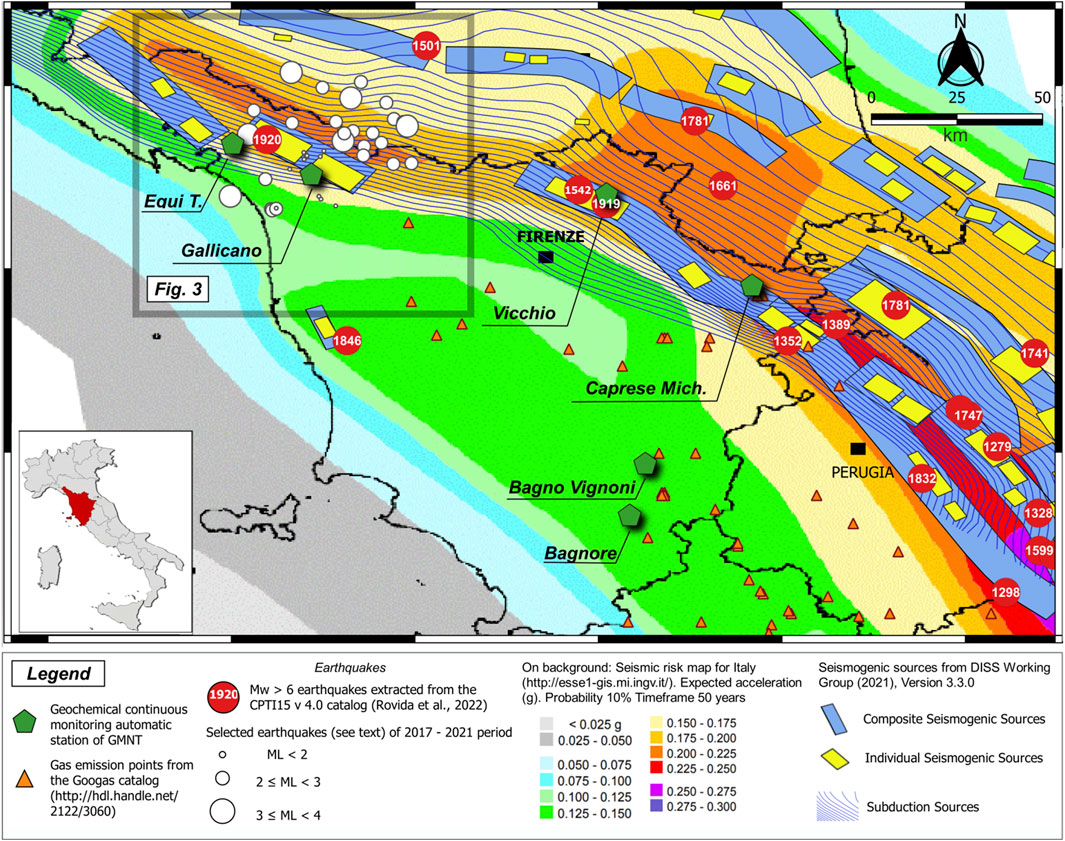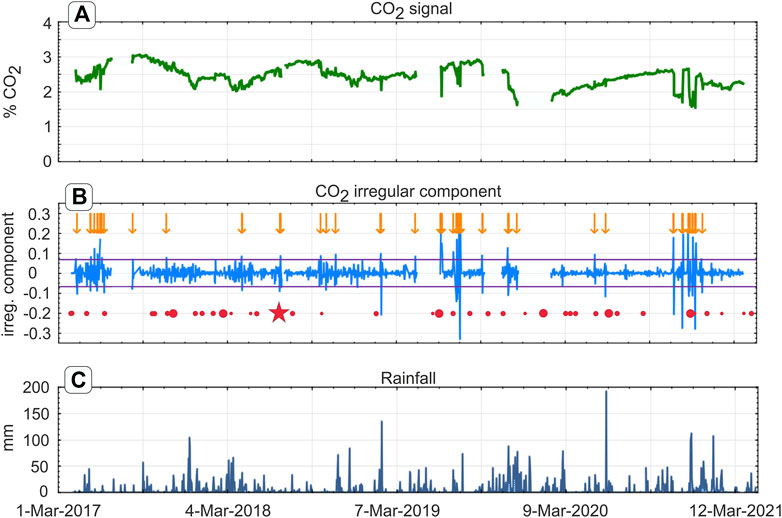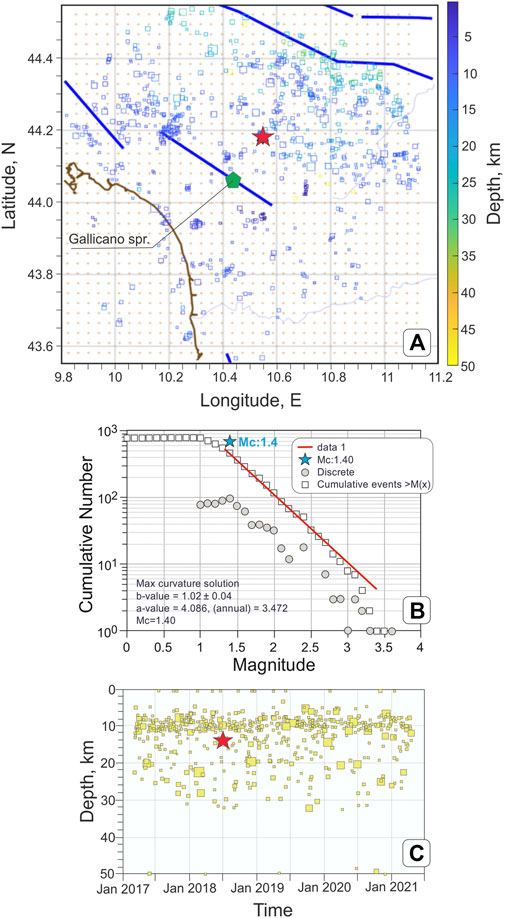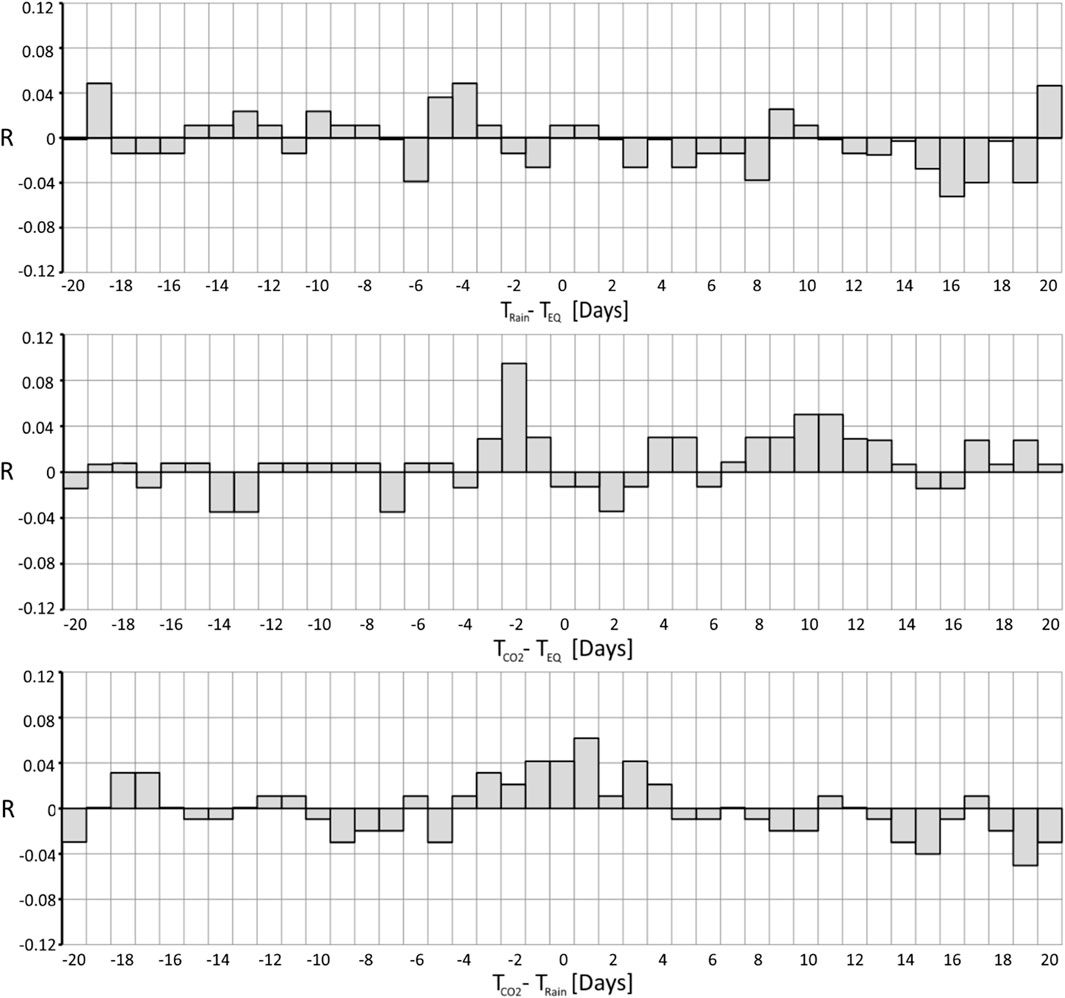
94% of researchers rate our articles as excellent or good
Learn more about the work of our research integrity team to safeguard the quality of each article we publish.
Find out more
BRIEF RESEARCH REPORT article
Front. Earth Sci., 17 July 2023
Sec. Geochemistry
Volume 11 - 2023 | https://doi.org/10.3389/feart.2023.1128949
This article is part of the Research TopicVolcanic and Tectonic Degassing: Fluid Origin, Transport and ImplicationsView all 11 articles
We correlated carbon dioxide (
The circulation of crustal fluids affects not only the transport of heat and chemical constituents, but also the mechanical processes that control rock deformation, and possibly generate earthquakes. Abnormal pressures in tectonically active areas were first reported by Anderson (1927), and overpressurized fluids were later identified as a primary agent of tectonic deformation by Hubbert and Rubey (1959). The observation of anomalous soil
In Central Italy, due to intense crustal deformation processes driven by the relative motion of the African and the Eurasian plates, two major areas affected by different tectonic and
The central-southern part of Apennines is a highly active seismic area, and some authors (e.g., Chiodini et al., 2004; 2020) have speculated that the existence of high-pressure,
Since early 1990s’, a large amount of information on the possible correlation between

FIGURE 1. Location of the Gallicano monitoring station and other sites of the GMNT. The tectonic background and the epicenters of relevant seismic events are also shown.
Here we report on
By discharging high-salinity Na-Ca-Cl waters (2.4 to 4.2
Operative since 2000, the automatic meteorological station of Gallicano (179 m.a.s.l., 44.064° Latitude North, and 10.443° Longitude East) is part of a regional network of about 440 manual and 133 automatic stations (Agro-Metereological Network) managed by the Regional Hydrological Service (SIR) of Tuscany. The station is located in the municipality of Gallicano, some 800 m ENE of the monitored spring, and acquires meteorological data every 5 min. Rainfall data for the period April 2017 to March 2021 are characterized by an average annual value of 1732

FIGURE 2. (A)
We downloaded earthquake data from the catalog of the ISIDe Working Group (Italian Seismological Instrumental and parametric database; http://iside.rm.ingv.it) to obtain a subset of “significant events” with magnitude greater or equal to 1.0. The set was declustered using the Reasemberg (1985); Gardner and Knopoff (1974) methods, as implemented in the zmap suite of Matlab tools (Wiemer, 2001). The focus was on the low seismicity period between 19 March 2017, to 18 April 2021. During this period, we identified 785 seismic events within a radius of 50 km from the Gallicano site, and a maximum hypocentral depth of 50 km. The estimated magnitude of completeness was 1.4 (Figures 3A, B), and the greatest observed local magnitude

FIGURE 3. (A) Declustered earthquake dataset (785 declustered events of 3402 seismic events registered during the period), before further reduction for correlation analysis (42 seismic events after reduction). Brown line: Tyrrhenian coastline; blue line: main local faults; green pentagon: location of the Gallicano monitoring station. Dimensions and colors of square symbols indicate earthquakes magnitudes and depths, respectively, while the red star marks the most energetic seismic event occurred in the period of interest. (B) frequency-magnitude distribution. (C) earthquakes depth distribution (overall dataset, before processing).
The identification of
with
We calculated the Pearson cross-correlation coefficient
where
In Eq. 3, the presence of
It was demonstrated (Fidani, 2018) that the conditional probability between two sets of digital events can be defined starting from the Matthews correlation. For negative values of the time shift (
The forecasting relation (4) means that if a correlation exists between
The
where
Given the symmetry around the averages, positive and negative thresholds were defined as
The purpose of the statistical treatment presented in this work was to explore possible correlations between declustered small earthquakes and
The time lag correlation was obtained by filling a histogram with each

FIGURE 4. Matthews correlation coefficients in the range Δt from −20 to +20 days of the time difference between earthquake and rain events (top),
The correlation plots were drawn for time differences
Based on Eq. 4, the correlation peak defines the conditional probability that a seismic event may occur 2 days after a
We propose a first comprehensive statistical analysis of
A key aspect of this analysis is that the observed positive correlation between
The raw data supporting the conclusion of this article will be made available by the authors, without undue reservation.
CF: Conceptualization, statistical method and interpretation, Writing the original draft, review and editing FG: conceptualization, hydrogeological and geochemical framework, writing the original draft, review and editing GF: instrument implementation and maintenance, acquisition of data series, writing the original draft, review and editing LP: conceptualization, hydrogeological and geochemical framework, writing the original draft, review and editing. All authors contributed to the article and approved the submitted version.
We warmly acknowledge the reviewers for their constructive criticisms, and L. Pinti for his editorial supervision.
The authors declare that the research was conducted in the absence of any commercial or financial relationships that could be construed as a potential conflict of interest.
All claims expressed in this article are solely those of the authors and do not necessarily represent those of their affiliated organizations, or those of the publisher, the editors and the reviewers. Any product that may be evaluated in this article, or claim that may be made by its manufacturer, is not guaranteed or endorsed by the publisher.
The Supplementary Material for this article can be found online at: https://www.frontiersin.org/articles/10.3389/feart.2023.1128949/full#supplementary-material
Anderson, R. V. V. (1927). Tertiary stratigraphy and orogeny of the Northern Punjab. Geol. Soc. Am. Bull. 38, 665–720. doi:10.1130/gsab-38-665
Barberio, M. D., Gori, F., Barbieri, M., Billi, A., Caracausi, A., De Luca, G., et al. (2020). New observations in Central Italy of groundwater responses to the worldwide seismicity. Sci. Rep. 10, 17850. doi:10.1038/s41598-020-74991-0
Barnes, I., Irwin, P. W., and White, D. E. (1978). “Global distribution of carbon dioxide discharges, and major zones of seismicity,” in Water resources investigation WRI 78-39 Editors I. Barnes, W. P. Irwin, and D. E. White (Washington: U.S. Geological Survey), 1–17.
Bowman, D. D., Ouillon, G., Sammis, C. G., Sornette, A., and Sornette, D. (1998). An observational test of the critical earthquake concept. J. Geophys. Res. 103, 24359–24372. doi:10.1029/98JB00792
Box, G. E. P., and Jenkins, G. M. (1976). Time series analysis: Forecasting and control. San Francisco: Holden Day.
Bräuer, K., Kämpf, H., Strauch, G., and Weise, S. M. (2003). Isotopic evidence (3He/4He, δ13C-CO2) of fluid-triggered intraplate seismicity. J. Geophys. Res. 108 (B2), 2070. doi:10.1029/2002JB002077
Brodsky, E. E., Roeloffs, E., Woodcock, D., Gall, I., and Manga, M. (2003). A mechanism for sustained groundwater pressure changes induced by distant earthquakes. J. Geophys. Res. 108, 88. doi:10.1029/2002JB002321
Camarda, M., Caracausi, A., Chiaraluce, L., De Gregorio, S., and Favara, R., (2018). Two years of geochemical monitoring along the Alto Tiberina Fault (Italy): New inferences on fluids and seismicity in central Apennines. In Proceedings of the 20th EGU General Assembly, Vienna, Austria, 4–13 April 2018.
Camarda, M., De Gregorio, S., Di Martino, R. M. R., and Favara, R. (2016). Temporal and spatial correlations between soil CO2 flux and crustal stress. J. Geophys. Res. 121, 7071–7085. doi:10.1002/2016JB013297
Cardellini, C., Chiodini, G., Frondini, F., Avino, R., Bagnato, E., Caliro, S., et al. (2017). Monitoring diffuse volcanic degassing during volcanic unrests: The case of campi flegrei (Italy). Sci. Rep. 7 (1), 6757–6815. doi:10.1038/s41598-017-06941-2
Chiodini, G., Cardellini, C., Amato, A., Boschi, E., Caliro, S., Frondini, F., et al. (2004). Carbon dioxide Earth degassing and seismogenesis in central and southern Italy. Geophys. Res. Lett. 31 (7). doi:10.1029/2004GL019480
Chiodini, G., Cardellini, C., Di Luccio, F., Selva, J., Frondini, F., Caliro, S., et al. (2020). Correlation between tectonic CO2 Earth degassing and seismicity is revealed by a 10-year record in the Apennines, Italy. Sci. Adv. 6 (35), eabc2938. eabc 2938. doi:10.1126/sciadv.abc2938
Cioni, R., Guidi, M., Pierotti, L., and Scozzari, A. (2007). An automatic monitoring network installed in Tuscany (Italy) for studying possible geochemical precursory phenomena. Nat. Hazards Earth Syst. Sci. 7, 405–416. doi:10.5194/nhess-7-405-2007
Cooper, H. H., Bredehoeft, J. D., Papadopulos, I. S., and Bennett, R. R. (1965). The response of well-aquifer systems to seismic waves. J. Geophys. Res. 70, 3915–3926. doi:10.1029/JZ070i016p03915
Dall'Aglio, M., Quattrocchi, F., and Venanzi, G. (1990). La stazione automatica per lo studio dei precursori geochimici nei colli albani: Il prototipo del sottosistema geochimico della rete sismica nazionale dell'ING. Proc. IX Convegno GNGTS 1990, CNR-Roma 1990, 95–100. (in Italian).
Di Bello, G., Heinicke, J., Koch, U., Lapenna, V., Macchiato, M., Martinelli, G., et al. (1998). Geophysical and geochemical parameters jointly monitored in a seismic area of Southern Apennines (Italy). Phys. Chem. Earth 23, 909–914. doi:10.1016/S0079-1946(98)00118-9
Di Martino, R. M., Camarda, M., Gurrieri, S., and Valenza, M. (2013). Continuous monitoring of hydrogen and carbon dioxide at Mt Etna. Chem. Geol. 357, 41–51. doi:10.1016/j.chemgeo.2013.08.023
DISS Working Group (2021). Database of individual seismogenic sources (DISS), version 3.3.0: A compilation of potential sources for earthquakes larger than M 5.5 in Italy and surrounding areas. United States: Istituto Nazionale di Geofisica e Vulcanologia. doi:10.13127/diss3.3.0
Dobrovolsky, I. P., Zubkov, S. I., and Miachkin, V. I. (1979). Estimation of the size of earthquake preparation zones. Pure Appl. Geophys. Pageoph 117, 1025–1044. doi:10.1007/bf00876083
Fidani, C. (2018). Improving earthquake forecasting by correlations between strong earthquakes and NOAA electron bursts. Terr. Atmos. Ocean. Sci. 29 (2), 117–130. doi:10.3319/tao.2017.10.06.01
Fidani, C. (2020). Probability, causality and false alarms using correlations between strong earthquakes and NOAA high energy electron bursts. Ann. Geophys. 63 (5), 543. doi:10.4401/ag-7957
Fidani, C. (2021). West pacific earthquake forecasting using NOAA electron bursts with independent L-shells and ground-based magnetic correlations. Front. Earth Sci. 9, 673105. doi:10.3389/feart.2021.673105
Fischer, T., Matyska, C., and Heinicke, J. (2017). Earthquake-enhanced permeability – evidence from carbon dioxide release following the ML 3.5 earthquake in West Bohemia. Earth Planet. Sci. Lett. 460, 60–67. doi:10.1016/j.epsl.2016.12.001
Gardner, J. K., and Knopoff, L. (1974). Is the sequence of earthquakes in Southern California, with aftershocks removed, Poissonian? Bull. Seismol. Soc. Am. 64, 1363–1367. doi:10.1785/bssa0640051363
Gherardi, F., and Pierotti, L. (2018). The suitability of the Pieve Fosciana hydrothermal system (Italy) as a detection site for geochemical seismic precursors. Appl. Geochem. 92, 166–179. doi:10.1016/j.apgeochem.2018.03.009
Giudicepietro, F., Chiodini, G., Caliro, S., De Cesare, W., Esposito, A. M., Galluzzo, D., et al. (2019). Insight into Campi Flegrei caldera unrest through seismic tremor measurements at Pisciarelli fumarolic field. Geochem. Geophys. Geosystems 20 (11), 5544–5555. doi:10.1029/2019gc008610
Gold, T., and Soter, S. (1979). Brontides: Natural explosive noises. Science 204, 371–375. doi:10.1126/science.204.4391.371
Gold, T., and Soter, S. (1985). Fluid ascent through the solid lithosphere and its relation to earthquakes. Pure Appl. Geophys. 122 (2), 492–530. doi:10.1007/bf00874614
Gold, T., and Soter, S. (1981). Response: Natural explosive noises. Science 212, 1297–1298. doi:10.1126/science.212.4500.1297
Gold, T. (1979). Terrestrial sources of carbon and earthquake outgassing. J. Petroleum Geol. 1 (3), 3–19. doi:10.1111/j.1747-5457.1979.tb00616.x
He, A., and Singh, R. P. (2020). Coseismic groundwater temperature response associated with the Wenchuan earthquake. Pure Appl. Geophys. 177, 109–120. doi:10.1007/s00024-019-02097-4
Heinicke, J., Koch, U., and Martinelli, G. (1995). CO2 and Radon measurements in the Vogtland area (Germany) - a contribute to earthquake prediction research. Geoph. Res. Lett. 22 (7), 771–774. doi:10.1029/94gl03074
Heinicke, J., Martinelli, G., and Telesca, L. (2012). Geodynamically induced variations in the emission of CO2 gas at san faustino (central Apennines, Italy). Geofluids 12, 123–132. doi:10.1111/j.1468-8123.2011.00345.x
Hubbert, M. K., and Rubey, W. W. (1959). Role of fluid pressure in mechanics of overthrust faulting: I. Mechanics of fluid-filled porous solids and its application to overthrust faulting. GSA Bull. 70 (2), 115–166.
Hunt, J. A., Zafu, A., Mather, T. A., Pyle, D. M., and Barry, P. H. (2017). Spatially variable CO2 degassing in the main Ethiopian rift: Implications for magma storage, volatile transport, and rift-related emissions. Geochem. Geophys. Geosyst. 18, 3714–3737. doi:10.1002/2017gc006975
Irwin, W. P., and Barnes, I. (1980). Tectonic relations of carbon dioxide discharges and earthquakes. J. Geophys. Res. 85 (B6), 3115–3121. doi:10.1029/jb085ib06p03115
Italiano, F., Martelli, M., Martinelli, G., Nuccio, P. M., and Paternoster, M. (2001). Significance of earthquake-related anomalies in fluids of Val D’Agri (southern Italy). Terra nova. 13 (4), 249–257. doi:10.1046/j.1365-3121.2001.00346.x
Italiano, F., Martinelli, G., and Rizzo, A. (2004). Geochemical evidence of seismogenic-induced anomalies in the dissolved gases of thermal waters: A case study of umbria (central Apennines, Italy) both during and after the 1997–1998 seismic swarm. Geochem. Geophys. Geosystems 5 (11), Q11001. doi:10.1029/2004GC000720
Johnson, N. L., Kotz, S., and Balakrishnan, N. (1995). “Chapter 28,” in Continuous univariate distributions. 2nd ed. (United States: Wiley).
King, C. Y., Zhang, W., and Zhang, Z. (2006). Earthquake-induced groundwater and gas changes. Pure Appl. Geophys. 163 (4), 633–645. doi:10.1007/s00024-006-0049-7
Kingsley, , Biagi, P., Piccolo, R., Capozzi, V., Ermini, A., Khatkevich, Y., et al. (2001). Hydrogeochemical precursors of strong earthquakes: A realistic possibility in kamchatka. Phys. Chem. Earth C 26 (10-12), 769–774. doi:10.1016/s1464-1917(01)95023-8
Lee, H., Muirhead, J. D., Fischer, T. P., Ebinger, C. J., Kattenhorn, S. A., Sharp, Z. D., et al. (2016). Massive and prolonged deep carbon emissions associated with continental rifting. Nat. Geosci. 9, 145–149. doi:10.1038/ngeo2622
Makridakis, S., Wheelwright, S. C., and Hyndman, R. J. (1998). Forecasting methods and applications. 3rd ed. New York: John Wiley and Sons, 642.
Manga, M., and Wang, C. Y. (2015). Earthquake hydrology. Treatise Geophys. 2015, 305–328. doi:10.1016/b978-0-444-53802-4.00082-8
Martinelli, G., and Albarello, D. (1997). Main constraints for siting monitoring networks devoted to the study of earthquake related phenomena in Italy. Ann. Geophys. 40, 1505–1522.
Martinelli, G., Ciolini, R., Facca, G., Fazio, F., Gherardi, F., Heinicke, J., et al. (2021). Tectonic-related geochemical and hydrological anomalies in Italy during the last fifty years. Minerals 11, 107. doi:10.3390/min11020107
Martinelli, G., and Dadomo, A. (2017). Factors constraining the geographic distribution of earthquake geochemical and fluid-related precursors. Chem. Geol. 469, 176–184. doi:10.1016/j.chemgeo.2017.01.006
Martinelli, G., Facca, G., Genzano, N., Gherardi, F., Lisi, M., Pierotti, L., et al. (2020). Earthquake-related signals in Central Italy detected by hydrogeochemical and satellite techniques. Front. Earth Sci. 8, 584716. doi:10.3389/feart.2020.584716
Massin, F., Farrell, J., and Smith, R. B. (2013). Repeating earthquakes in the yellowstone volcanic field: Implications for rupture dynamics, ground deformation, and migration in earthquake swarms. J. Volcanol. Geotherm. Res. 257, 159–173. doi:10.1016/j.jvolgeores.2013.03.022
Matthews, B. W. (1975). Comparison of the predicted and observed secondary structure of T4 phage lysozyme. Biochimica Biophysica Acta (BBA) - Protein Struct. 405 (2), 442–451. doi:10.1016/0005-2795(75)90109-9
Molchanov, O. A., and Hayakawa, M. (2008). Seismo-electromagnetics and related phenomena. Tokyo: Terrapub.
Molli, G., Manighetti, I., Bennett, R., Malavieille, J., Serpelloni, E., Storti, F., et al. (2021). Active fault systems in the inner northwest Apennines, Italy: A reappraisal one century after the 1920 Mw∼6.5 fivizzano earthquake. Geosciences 11 (3), 139. doi:10.3390/geosciences11030139
Netreba, A. V., Fridman, A. I., Plotnikov, I. A., and Khurin, M. I. (1971). On the large-scale mapping of closed ore-bearing areas in the north Caucasus with the uses of gas surveying as a geochemical method. Geokhimia 8, 1016–1021. (in Russian).
Ohnaka, M. (1992). Earthquake source nucleation: A physical model for short term precursors. Tectonophysics 211, 149–178. doi:10.1016/0040-1951(92)90057-D
Pearson, K. (1916). Mathematical contributions to the theory of evolution, XIX: Second supplement to a memoir on skew variation. Philosophical Trans. R. Soc. A 216 (538–548), 429–457.
Pering, T. D., Tamburello, G., McGonigle, A. J. S., Aiuppa, A., Cannata, A., Giudice, G., et al. (2014). High time resolution fluctuations in volcanic carbon dioxide degassing from Mount Etna. J. Volcanol. Geotherm. Res. 270, 115–121. doi:10.1016/j.jvolgeores.2013.11.014
Pierotti, L., Botti, F., D’Intinosante, V., Facca, G., and Gherardi, F. (2015). Anomalous CO2 content in the Gallicano thermo-mineral spring (serchio valley, Italy) before the 21 june 2013, alpi apuane earthquake (M= 5.2). Phys. Chem. Earth, Parts A/B/C 85, 131–140. doi:10.1016/j.pce.2015.02.007
Pierotti, L., Gherardi, F., Facca, G., Piccardi, L., and Moratti, G. (2017). Detecting CO2 anomalies in a spring on Mt. Amiata volcano (Italy). Phys. Chem. Earth, Parts A/B/C 98, 161–172. doi:10.1016/j.pce.2017.01.008
Reasenberg, P. (1985). Second-order moment of central California seismicity, 1969-1982. J. Geophys. Res. 90, 5479–5495. doi:10.1029/jb090ib07p05479
Rebetsky, Y. L., and Lermontova, A. S. (2018). On the long-range influence of earthquake rupture zones. J. Volcanol. Seismol. 12, 341–352. doi:10.1134/S0742046318050068
Rikitake, T. (1994). Nature of macro-anomaly precursory to an earthquake. J. Phys. Earth 42, 149–163. doi:10.4294/jpe1952.42.149
Rovida, A., Locati, M., Camassi, R., Lolli, B., Gasperini, P., and Antonucci, A. (2022). Catalogo Parametrico dei Terremoti Italiani (CPTI15). versione 4.0. Italy: Istituto Nazionale di Geofisica e Vulcanologia. doi:10.13127/CPTI/CPTI15.4
Shi, Z., and Wang, G. (2014). Hydrological response to multiple large distant earthquakes in the Mile well, China. J. Geophys. Res. 119, 2448–2459. doi:10.1002/2014JF003184
Sil, S., and Freymueller, J. T. (2006). Well water level changes in Fairbanks, Alaska, due to the great Sumatra-Andaman earthquake. Earth Planets Space 58, 181–184. doi:10.1186/BF03353376
Statsoft Inc. (2013). STATISTICA (data analysis software system) version 12 for windows: Statistics. Tulsa, OK.: STATSOFT Inc.
Stucchi, M., Meletti, C., Montaldo, V., Crowley, H., Calvi, G. M., and Boschi, E. (2011). Seismic hazard assessment (2003–2009) for the Italian building code. Bull. Seismol. Soc. Am. 101 (4), 1885–1911. doi:10.1785/0120100130
Tamburello, G., Pondrelli, S., Chiodini, G., and Rouwet, D. (2018). Global-scale control of extensional tectonics on CO2 Earth degassing. Nat. Commun. 9, 4608. doi:10.1038/s41467-018-07087-z
Velleman, P. F., and Hoaglin, D. C. (1981). Applications, basics, and computing of exploratory data analysis. Boston, MA: Duxbury Press.
Ventura, G., Cinti, F. R., Di Luccio, F., and Pino, N. A. (2007). Mantle wedge dynamics versus crustal seismicity in the Apennines (Italy). Geochem. Geophys. Geosys. 8, Q02013. doi:10.1029/2006gc001421
Weinlich, F. H., Faber, E., Boušková, A., Horálek, J., Teschner, M., and Poggenburg, J. (2006). Seismically induced variations in mariánské lázně fault gas composition in the NW bohemian swarm quake region, Czech republic—a continuous gas monitoring. Tectonophysics 421 (1-2), 89–110. doi:10.1016/j.tecto.2006.04.012
Wiemer, S. (2001). A software package to analyze seismicity: ZMAP. Seismol. Res. Lett. 72 (3), 373–382. doi:10.1785/gssrl.72.3.373
Woith, H., Petersen, G. M., Hainzl, S., and Dahm, T. (2018). Review: Can animals predict earthquakes? Bull. Seismol. Soc. Am. 108, 1031–1045. doi:10.1785/0120170313
Yoshida, K., and Hasegawa, A. (2018). Hypocenter migration and seismicity pattern change in the yamagata-fukushima border, NE Japan, caused by fluid movement and pore pressure variation. J. Geophys. Res. Solid Earth 123 (6), 5000–5017. doi:10.1029/2018jb015468
Keywords: statistical correlations, conditional probability, small earthquakes, hydrogeochemical continuous monitoring, CO2 time series
Citation: Fidani C, Gherardi F, Facca G and Pierotti L (2023) Correlation between small earthquakes and
Received: 21 December 2022; Accepted: 06 July 2023;
Published: 17 July 2023.
Edited by:
Daniele L. Pinti, Université du Québec à Montréal, CanadaReviewed by:
Giovanni Martinelli, National Institute of Geophysics and Volcanology, Section of Palermo, ItalyCopyright © 2023 Fidani, Gherardi, Facca and Pierotti. This is an open-access article distributed under the terms of the Creative Commons Attribution License (CC BY). The use, distribution or reproduction in other forums is permitted, provided the original author(s) and the copyright owner(s) are credited and that the original publication in this journal is cited, in accordance with accepted academic practice. No use, distribution or reproduction is permitted which does not comply with these terms.
*Correspondence: F. Gherardi, Zi5naGVyYXJkaUBpZ2cuY25yLml0
Disclaimer: All claims expressed in this article are solely those of the authors and do not necessarily represent those of their affiliated organizations, or those of the publisher, the editors and the reviewers. Any product that may be evaluated in this article or claim that may be made by its manufacturer is not guaranteed or endorsed by the publisher.
Research integrity at Frontiers

Learn more about the work of our research integrity team to safeguard the quality of each article we publish.